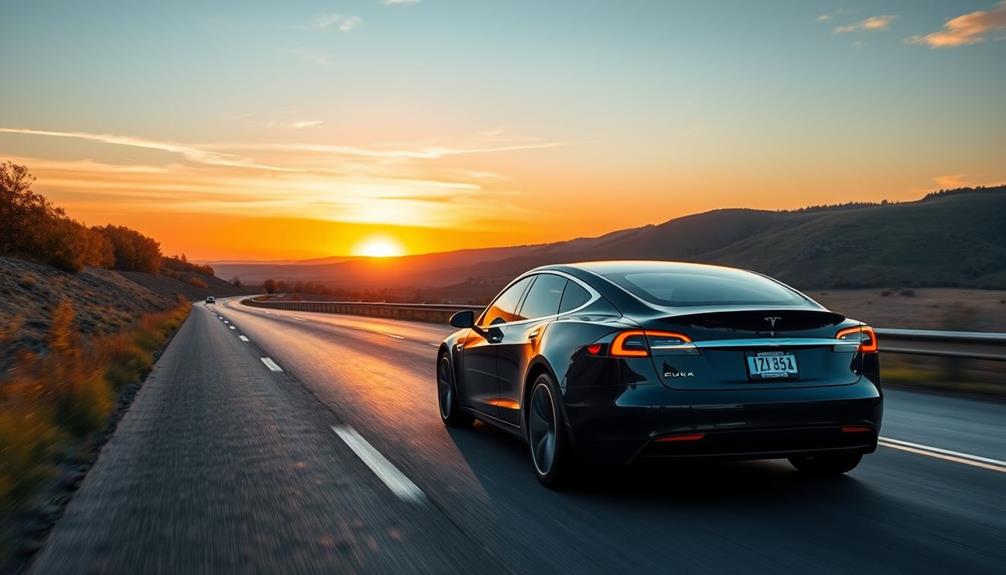Yes, you can charge your Tesla in the rain. Modern charging systems are designed with safety in mind. Weatherproof chargers and sealed connections help prevent electric shock. They come with GFCI protections that cut off power if water is detected, ensuring your safety. Many drivers have successfully charged their vehicles in wet conditions without issues. However, it's smart to avoid charging in severe rain and seek a sheltered spot when possible. Maintaining a towel to dry off the connections can also help enhance your experience. Want to know more about how to charge safely during storms?
Key Takeaways
- Charging a Tesla in the rain is generally safe due to advanced weatherproof technology and compliance with safety standards.
- Weatherproof connectors and sealed charging ports prevent water ingress, minimizing the risk of electrical shock.
- Electric Vehicle Supply Equipment (EVSE) includes GFCIs that disconnect power upon detecting water, enhancing safety during wet conditions.
- Many Tesla owners report positive experiences charging in the rain, as concerns about battery health in wet conditions are largely unfounded.
- Best practices include avoiding severe rain and using dedicated charging stations designed for outdoor use to ensure safe charging.
Safety of Charging in Rain
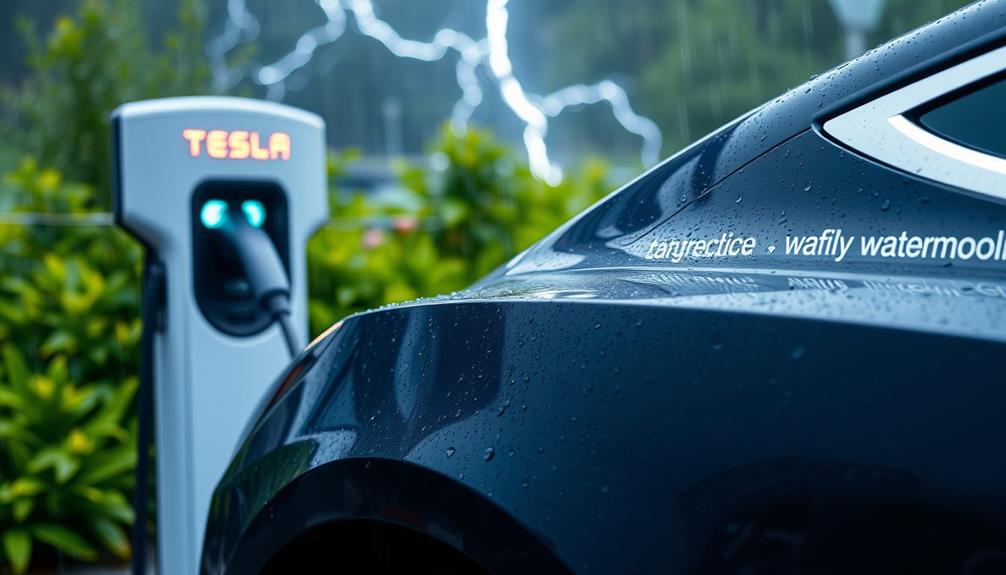
Charging your electric vehicle in the rain is generally safe, thanks to advanced technology designed to protect you. Electric vehicles (EVs), including Teslas, come equipped with weatherproof chargers that prevent electrical shock. These chargers comply with rigorous safety standards, guaranteeing you can charge your car without worry, even during storms.
The electric vehicle supply equipment (EVSE) features ground fault circuit interrupters (GFCIs) that automatically disconnect power if they detect water ingress. This crucial safety feature adds additional peace of mind while you're charging in the rain.
Furthermore, the charging ports on Teslas and other electric vehicles are sealed and insulated, effectively blocking water from reaching critical components.
Manufacturers put EV charging systems through extensive testing, including fire hose testing for waterproofing, to assure reliability in adverse weather. Federal law mandates that electric vehicle chargers meet consumer product safety standards, guaranteeing these systems are safe for use in all conditions.
Technology Behind Charging Systems
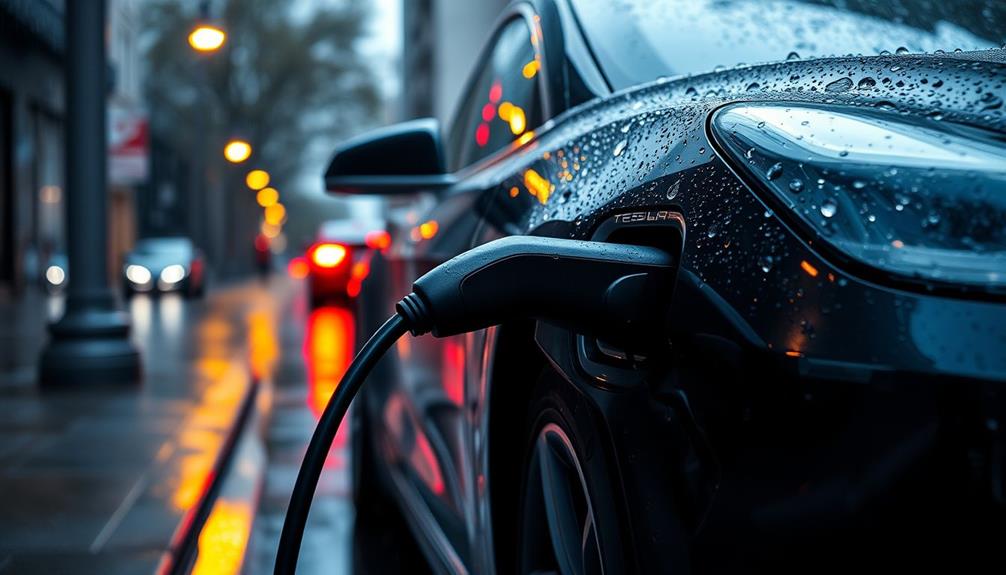
Electric vehicle charging systems are built with advanced technology to guarantee safety and reliability, especially in challenging weather conditions. These systems feature weatherproof connectors that are rigorously tested, including fire hose testing, to verify they can withstand inclement weather.
The incorporation of Ground Fault Circuit Interrupter (GFCI) protection automatically disconnects power during a ground fault, minimizing electrical hazards when it rains.
Moreover, the Electric Vehicle Supply Equipment (EVSE) guarantees that high voltage isn't delivered until secure connections are established, further reducing the risk of electrocution.
You'll find that charging cables and connectors are engineered to endure harsh conditions, equipped with weatherproof enclosures and seals that prevent water ingress, which could otherwise lead to short circuits.
Manufacturers take safety seriously, conducting thorough testing to confirm that charging systems maintain functionality and safety in various environmental conditions, including rain and humidity.
These safety features are a vital part of the design, ensuring that you can charge your electric vehicle without worry, even when the weather isn't cooperating.
With these robust technologies, you can trust that your charging experience will be safe and reliable, rain or shine.
User Experience in Wet Conditions
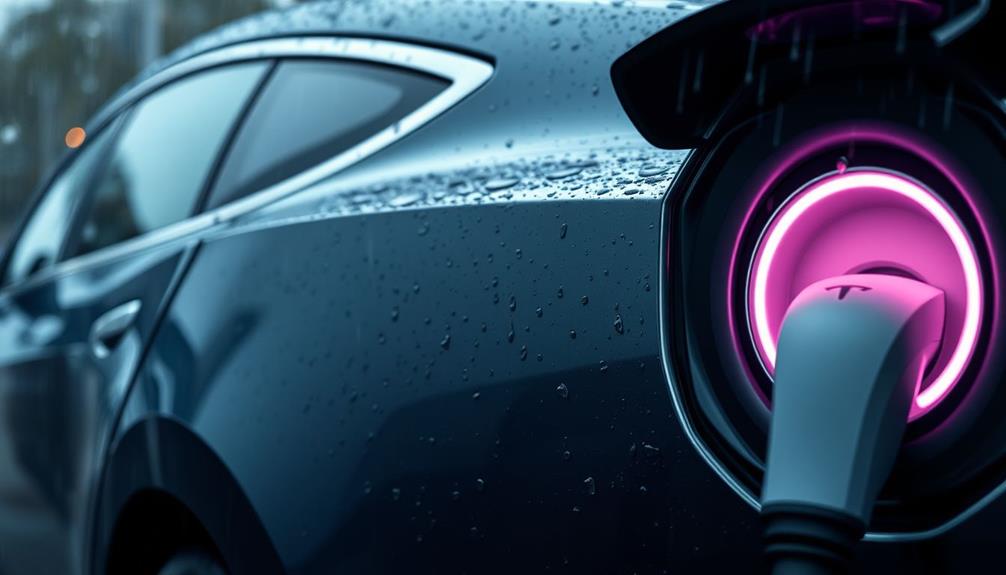
Many drivers have reported positive experiences while charging their electric vehicles in the rain, highlighting that modern technology effectively guarantees safety and efficiency.
As a Tesla owner, you can charge your vehicle confidently, knowing that the charging ports are weatherproof and designed to prevent electric shock, even in wet conditions. Additionally, Tesla’s charging infrastructure is extensive, with Supercharger stations located strategically throughout the country, making it convenient for owners to recharge their vehicles on long road trips. The Tesla charging costs are also competitive, with several different payment options available to suit individual needs. With the peace of mind of weatherproof charging ports and the convenience of a widespread charging network, owning a Tesla is not only a sustainable choice but also a practical one.
User education on charging safety plays a crucial role, as real-life experiences demonstrate that most EVs function reliably in inclement weather.
While some might worry about battery health after exposure to rain, the consensus is that these concerns are largely unfounded.
Here are a few tips to enhance your user experience while charging your Tesla in the rain:
- Choose covered charging locations when possible.
- Regularly inspect your charging equipment for signs of wear.
- Stay informed about local charging station conditions.
- Familiarize yourself with your vehicle's safety requirements.
Environmental Impact of Rain Charging
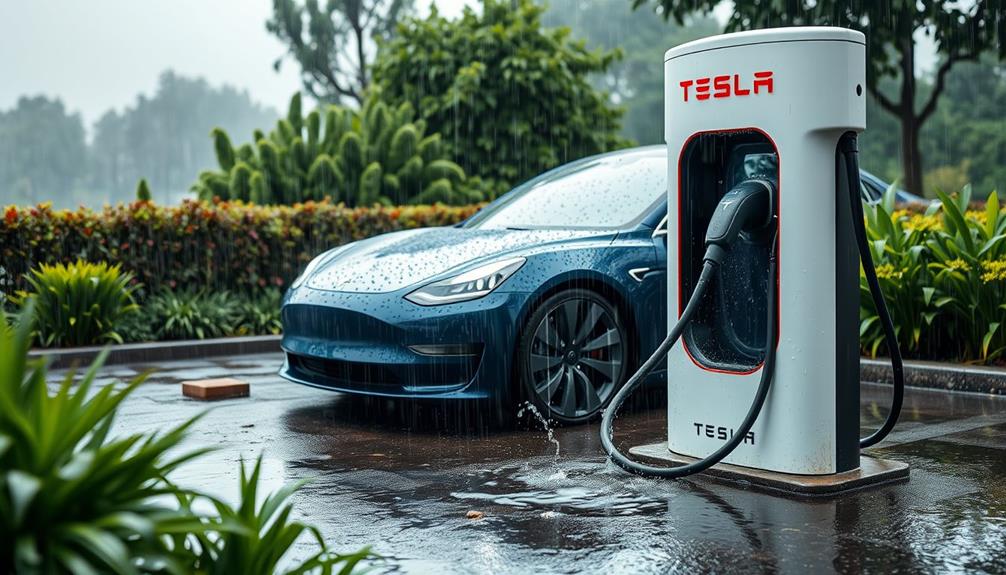
Utilizing rain for charging not only keeps your electric vehicle ready for the road but also offers significant environmental benefits. When you charge your EV during wet weather, you can tap into renewable energy sources like solar panels at charging stations. This practice helps reduce the carbon emissions typically associated with electricity generation, enhancing your vehicle's overall environmental impact.
Moreover, the increased adoption of rain-compatible charging infrastructure promotes lower greenhouse gas emissions, which is vital for climate change mitigation. Some charging stations even implement rainwater harvesting systems, using collected rainwater for maintenance and irrigation.
By charging during storms, you can also help stabilize the electrical grid, as lower electricity demand often coincides with your charging needs.
It's important to remember that charging your electric vehicle in various weather conditions remains safe. Charging stations are designed with measures to guarantee you're protected from electrical shock, allowing you to enjoy the benefits of rain charging without concerns.
Best Practices for Safe Charging
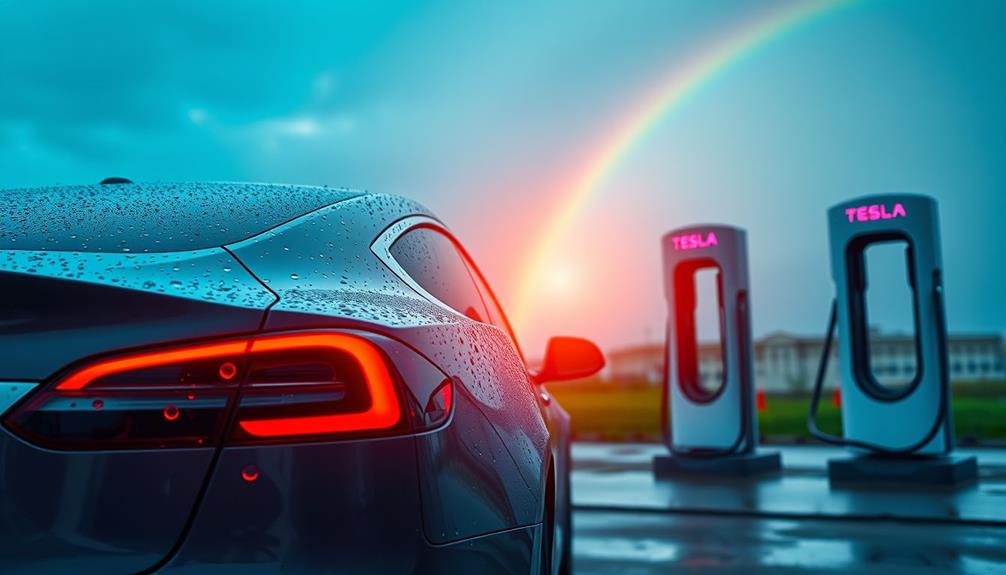
When charging your electric vehicle, it's important to prioritize safety, especially in rainy conditions. To guarantee it's safe to charge your Tesla or any electric car during bad weather, follow these best practices:
- Always use Electric Vehicle Supply Equipment (EVSE) that meets safety standards.
- Avoid charging in severe rain; seek sheltered locations instead.
- Carry a towel to wipe down the charging plug and vehicle input before and after charging.
- Verify charging cables aren't exposed to standing water or puddles.
These steps help protect your EV batteries from moisture-related issues. Regularly inspect and maintain your charging equipment to check for waterproof seals and proper functionality.
Additionally, if you're using a dedicated charging station, confirm it's designed for outdoor use and capable of handling wet conditions.
By taking these precautions, you greatly reduce the risks associated with charging your vehicle in inclement weather.
Remember, while it's generally safe to charge in the rain, being proactive about your charging port and connection can prevent potential hazards.
Stay safe and enjoy your electric car experience, rain or shine!
Frequently Asked Questions
Is It Safe to Charge a Tesla While Raining?
Yes, it's safe to charge your Tesla while it's raining. The charging ports are designed to withstand wet conditions, and safety features like GFCI protect against any electrical issues. Just avoid charging during severe storms.
Is It Safe to Charge EV While Raining?
Charging an EV in the rain might seem risky, but it's actually safe. The equipment's designed to keep you secure, preventing any issues. Just guarantee everything's properly connected, and you're good to go, rain or shine!
Is It Safe to Charge a Tesla During a Thunderstorm?
Charging a Tesla during a thunderstorm is generally safe. Modern systems protect against electrical hazards, and the risk of shock is minimal. Just guarantee your equipment is well-maintained and avoid charging in extremely severe conditions.
How to Protect a Tesla Charger From Rain?
Did you know that 80% of EV charging occurs at home? To protect your Tesla charger from rain, use a wall-mounted charger, keep connectors dry, and consider protective covers to minimize moisture exposure.
Conclusion
Charging your Tesla in the rain isn't just safe; it's as reliable as a sunny day. With advanced technology designed to handle wet conditions, you can plug in without worry. Just keep a few best practices in mind, like using a covered area when possible. So, go ahead and charge up, even when the clouds roll in. After all, you can't let a little rain dampen your electric ride!




